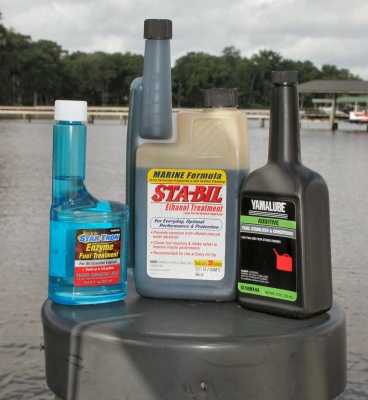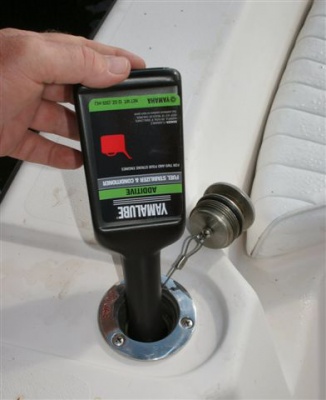Winterizing Your Boat
Purchase Winterizing Products in our Online Store
It's time to winterize your boat and here is what needs to be done to protect your boat when it is laid up for the winter.
Winterizing Checklist
Sterndrives/Inboards
1. Install gas stabilizer
2. Change engine oil and filter
3. Change fuel filter
4. Drain block, manifolds, circulating pump and coolers.
5. Fill block, manifolds and circulating pump with anti-freeze.
6. Check all belts and hoses.
7. Check shift/throttle cables and settings.
8. Change gear lube.
9. Check gimbal bearing
10. Grease u-joints and gimbal bearing
11. Lube engine coupler splines
12. Check and replace anodes as needed
13. Run, decarbon and fog engine
14. Spray electrical connections with corrosion guard
15. Check steering and power trim
Outboards
1. Change gear lube
2. Grease tilt tube and swivel pin
3. Change oil & Filter in all 4S
motors.
4. Check steering
5. Check shift/throttle cables
6. Check and replace anodes as needed
7. Install gas stabilizer
8. Run, decarbon and fog engine
9. Check fuel line and bulb
10. Spray electrical connections with corrosion guard
11. Top of power trim fluid
We recommend you use genuine Mercury, Yamaha and Volvo-Penta parts and accessories when you winterize your boat.
Remember to change your engine oil and filter in the fall when you winterize your boat. Do not put your boat in storage with dirty oil. After just a few hours of use your engines oil is dirty and contaminated, with water, acids, unburned gas and dirt. Dirty oil can damage your engine if left in over the winter months. If you do not change the oil it will start to corrode the metal surfaces of the engine and damage bearings, pistons and cylinder walls. It is especially important in diesel engines because excess sulfur in the fuel when combined with water from condensation will become sulfuric acid , and can cause major damage to your engine.
Make sure you use a good brand of marine engine oil, such as Mercury/Quicksilver Mercruiser oil or Four Stroke oil, Volvo Penta oil and Yamahalube Four Stroke oil which all contain the proper detergents and rust inhibitors. Some automotive oils do not meet these standards and you should always refer to your owners manual for the proper weight and type of oil to use.
You should also pull your outdrive and check the gimbal bearing, it should be lubed and replaced if needed. Drain the oil and refill with new gear oil. Make sure there is no water intrusion in your outdrive and if there is, it may need to be resealed. Make sure you keep your outdrive down when in storage.
Next stabilize your gas (and then spray fogging oil through the carburetor until the engine stalls.(We recommend Mercury Storage Seal or Yamaha Stor-Rite Fogging Oil) If you have an EFI or MPI engine you will have to pull the spark plugs and spray the fogging oil through the plug holes.(10 seconds per hole) Be sure that you turn the engine over to make sure the fogging oil coats everything.Change all fuel filters including your water seperator fuel filter.
Drain the water from your engine and manifolds and refill with a non-toxic anti-freeze do not use automotive engine coolant for this purpose.Make sure it has a Corrosion Inhibitor, not all RV Anti-Freeze has this additive which is ment to be used in engines.
Finally spray your electrical connections with Mercury corrosion guard or Yamaha Silicone Spray.which will protect them. Check your belts, hoses and anodes. Replace them if needed. Check your throttle and steering cables, make sure you spray them with a weather resistant lubricant such as CRC or WD40. Pull you propeller and lube with anti-seize weatherproof grease. Disconnect or remove your batteries and you are ready to put your boat in storage.
Remember Boats Unlimited stocks everything you need to protect your boat in winter storage.
Purchase Winterizing Products in our Online Store
E-10 Bulletin
Important E10 Information for Marine & Boat Owners
Mercury – Mercruiser - OMC Cobra - BRP - Evinrude
- Honda - Indmar - Yamaha - Tohatsu - Suzuki...

It is dangerous to use greater than 10 % ethanol in marine engines.
If you own a boat and outboard motor, and you’ve not yet run afoul of E10 gasoline, count your lucky stars. Better yet, get informed fast on the dangers to your motor that E10 fuel potentially has, or it can cost you lots of down-time from fishing and boating, and plenty of money, too.
No matter where you live, you’re likely aware of E10 fuel, since it’s sold at most roadside gas stations throughout America. In many states, like here in New York State, E10 fuel is the law, and the norm, virtually everywhere cars fuel up.
You’ve likely seen E10 decals on fuel pumps when you’re filling your car. They state that fuel sold at that station has "no more than 10-percent ethanol." Ethanol is an oil-alternative alcohol-based fuel, usually made from corn, and mandated by government to supposedly lessen America’s dependence on foreign oil.
Boaters, often store fuel in tanks longer than recommended for E10 (30 days max, less in hot humid conditions).
Although every major manufacturer of outboard motors reports their engines run just fine on E10 fuel, spokespersons for those same companies know that in the real world of fishing and boating, E10 can be a disaster.
Here’s why E10 contributes to boat fuel system problems, according to a Yamaha marine retail bulletin:
- Ethanol is hygroscopic, meaning it has a strong attraction to moisture.
- Ethanol increases the amount of water accumulating in fuel tanks.
- Ethanol produces less energy (BTUs) than an equivalent unit of gasoline.
- E10 fuel’s usable life span may be less than the normal length of off-season boat storage.
- Ethanol is a strong cleaner (solvent).
- Ethanol will clean gum and varnish as well as surface corrosion from any surface it contacts in a boat fuel system as well as storage and transport tanks in a fuel distribution system.
- Ethanol may dissolve plastic resins used to make some fiberglass fuel tanks.
Several older engines can not use any fuels that contain alcohol. e.g. Certain fiberglass tanks, mostly manufactured prior to 1992, will decompose from alcohol.
One of the biggest boating issues of E10 fuel is it has the unhappy ability to attract water. And as almost everyone knows, water in gas engines is a serious problem. To help stem that flow into your outboard, be sure you have a high-quality (25-micron minimum) marine fuel-water separator (filter) installed in the gas line, and check it and replace it often. This filter prevents not only water from getting to the engine, but also debris that may result from ethanol degrading a boat fuel tank and gas lines.
"When checking a boat fuel-water separator, pour the gas out of it into a clear container and see if there is water and/or debris in it, if the fuel you pour out of the separator is milky or cloudy, you’ve got a problem. Completely draining gas from a tank may be necessary. Sometimes an entire fuel line system must be changed. Fiberglass tanks are a real problem with ethanol, and should be replaced with metal tanks. Outboard fuel injectors commonly foul, and must be replaced if contaminated with water or debris from E10. Once you have an E10 problem in a motor or boat, it can be very difficult solving it for good. It’s very common during the warm-weather fishing season, especially in the South."
Regular changing of a fuel separator is recommended by many of the outboard companies. Installing a new separator for every 50 hours of running time is a good idea, more often if you have on-going problems.
Another recommended procedure to thwart the wrath of E10 is to regularly use a commercial fuel additive designed specifically for ethanol. Many outboard companies produce such additives, with Yamaha’s "Yamalube," Star Brite’s "StarTron Enzyme Fuel Treatment," and Sta-Bil’s "Ethanol Treatment" among the industry leaders. Buy Now in our Online Store.
Use an additive every time you add fuel.
Boat engines live in a water environment - Alcohol fuel loves to absorb water.
Ethanol absorbs water - Water molecules combine with petroleum (petrol) in your fuel tank and lines...Ethanol has an increased risk of fuel water-contamination due to ability to absorb H20.
(Ethanol attracts and absorbs moisture from the air). Vapor lock and fuel starvation can occur.
Make sure your motor is equipped with a water separating fuel filter
Experts advise keeping boat fuel tanks completely full of gas at all times. This reduces the air gap at the top of a tank, so there is less chance for water condensation to form to contaminate fuel. Full tanks are especially important during hot summer weather, particularly in the South.
Because E10 degrades rapidly, it’s not a good idea to leave this fuel in a motor tank for long duration (over 90 Days), which in the real outboard world is common even during the height of the fishing and boating season. For winter storage, draining a fuel tank is worthwhile.
Government agencies pressing ethanol use have recognized the problem the fuel has in outboards and RVs (not cars, so far), so in some places regular old gasoline without ethanol is available. Some marinas sell it, and while it’s about $1 more per gallon, it’s cost effective to use to avoid E10 headaches. But non-E10 fuel can be difficult to locate.

Next up, E15 fuel, which is being strongly advocated by regulatory agencies, since it’s made of 15 percent ethanol.
USA Note - A recent post on a Long Island, NY message board states, "Believe it or not, some of the fuel samples tested 48 % ethanol and most were above the 10 % 'maximum allowable by law'.".
|